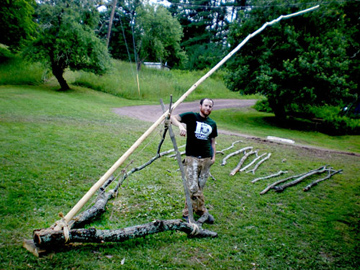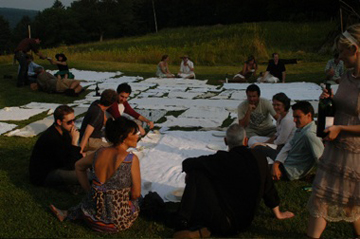Relational art functions as a response to the technological advances of everyday life, with virtual profiles acting as surrogates for human interaction. Less obvious are the ways in which the art institution embraces or rejects it. How does the alternative model of education reiterate artists’ philosophies of social practice and how has the myth of the “Art School Crisis” become a catalyst for these alternatives? The popularity of artist-run schools like Olafur Eliasson’s Institut für Raumexperimente and Mark Dion’s Mildred’s Lane Project prove that social practice has moved out of the white cube and into the educational system to become a vital influence on contemporary art education.
Consider Eliasson’s Institut für Raumexperimente in Berlin and Mark Dion’s Mildred’s Lane Project in Pennsylvania where the curriculum is a direct consequence of the artists’ practice. In these settings, art must make a connection between working, living, research and experimentation. According to Eliasson, the problem with traditional art education is clear. “The hierarchical transmission of knowledge practiced in many art schools is clearly unproductive: the inflexible categories of ‘teacher’ and ‘student’ working in a sealed-off environment…have taken responsibility away from the students, distancing them from real work in real life.” As a laboratory, his Institute promotes experimentation as a means to “make the voice of art heard” while its participants form a relationship with the members of the community. Dion’s Mildred’s Lane, situated on 92 acres in rural Pennsylvania, is a collaborative long-term experiment between artists Dion and J. Morgan Puett. The research-driven art projects encourage the connectedness of art practice to everyday life by questioning students’ art practice in relation to their environment. To rethink the studio, the students visit alternative farms and discuss cooking and cleaning as part of the course of study.

Mildred’s Lane Fellow Tyler McPhee works on a project for "DeepCraft: Bioregional Innovation Project." Photo by David Brooks
Claire Bishop‘s critique, “Antagonism and Relational Aesthetics,” allows us to see the pitfalls of the art project as art school. The article posits that there is no scale from which to measure its successes or failures because there is no established history of social-based art practice. For Bishop, this type of “feel good” art feels too shallow. It’s too easy to celebrate philosophies of generosity, and at the same time, critique the exclusivity and limitations of these projects. Historically, the system has never been inviting to outsiders and the discussion taking place within the white cube is exclusive. Art dealers, collectors, and young art fans participate in a closed discussion about their elite interests. The “collective” community is a fallacy.
Bishop’s answer to the contradictions of the relational art model is true democracy via antagonism, specifically illustrated by the works of Santiago Sierra and Thomas Hirschhorn, in which realism trumps idealism. Bishop points out that the works of Sierra and Hirschhorn do not rely on the viewer to complete the work. In fact, the viewer is often made to feel quite uncomfortable. Bishop’s call for antagonism and autonomy in art is particularly relevant to the argument for alternative art schools.
Questions about the interconnectedness of the university and the marketplace create a valuable framework from which to examine alternative art schools in relation to social practice. We shouldn’t ignore the alleged “crisis of the university” happening simultaneously with new M.F.A. programs in Social Practice popping up all over art institutions. The “crisis” of the art school is a myth. Enrollment in M.F.A. programs is reaching record numbers. While universities are faced with financial and budgeting crises, there appears to be no lack of interest in the pursuit of higher education. The “crisis” actually helps expand the institution. Continued debate on the state of the university system inevitably generates public interest and initiates the discussion of alternatives. As Claire Bishop writes, if antagonism does not exist, the system would not be democratic. The antagonism in this case is the relational aesthetic version of art school, the anti-institution, the art school as “microtopia.”
Like relational aesthetics, within the alternative art school there is some crossover between institutionalized studio activity and the laboratory/workshop structure. The alternative school is itself a critique of the institution. But what problems are alternative schools attempting to solve? Is it not responding to some “crisis” in art education, the paradoxical dictatorship of artistic freedom influenced by the marketplace?
Institutional critique has the potential to encourage the discovery of more effective systems. In fact, this rejection of old models is the basis of modernism. However, we must be cautious about readily accepting new models without some form of critique. Like relational art, it is difficult to judge successes and failures of these contemporary academies when there is such a brief history from which to compare. Having endless choice is the basis of a democratic society and refusal to accept the status quo helps keep the dialogue open and varied. Out of this refusal comes new forms of art and innovation. The popularity of relational art has naturally influenced an institutional critique and a resulting re-evaluation of the art institution. The school has become the experiment. Ultimately, the beauty of the antagonism between old and new is that myriad possibilities are created as a result. As critics, we are responsible for establishing a fair scale to evaluate these new alternatives.
Meredith Carty MacKenzie is a student at the San Francisco Art Institute.




Pingback: Gastro-Vision | On Soup | Art21 Blog
Pingback: Relational Aesthetics is the New Black: DIY Art School | postmediabooks